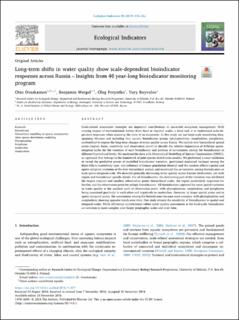| dc.description.abstract | Scale-related assessment strategies are important contributions to successful ecosystem management. With varying impact of environmental drivers from local to regional scales, a focal task is to understand scale-dependent responses when assessing the state of an ecosystem. In this study we use large-scale monitoring data, spanning 40 years and including four aquatic bioindicator groups (phytoplankton, zooplankton, periphyton, zoobenthos) to expose the long-term changes of water quality across Russia. We include four hierarchical spatial scales (region, basin, waterbody and observation point) to identify the relative importance of different spatio-temporal scales for the variation of each bioindicator and patterns of co-variation among the bioindicators at different hierarchical levels. We analysed the data with Hierarchical Modelling of Species Communities (HMSC), an approach that belongs to the framework of joint species distribution models. We performed a cross validation to reveal the predictive power of modelled bioindicator variation, partitioned explained variance among the fixed effects (waterbody type, and influence of human population density) and the random effects (spatial and spatio-temporal variation at the four hierarchical scales), and examined the co-variation among bioindicators at each spatio-temporal scale. We detected generally decreasing water quality across Russian freshwaters, yet with region and bioindicator specific trends. For all bioindicators, the dominating part of the variation was attributed the largest (region) and smallest (observation point) hierarchical scales, the region particularly important for benthic and the observation point for pelagic bioindicators. All bioindicators captured the same spatial variation in water quality at the smallest scale of observation point, with phytoplankton, zooplankton and periphyton being associated positively to each other and negatively to zoobenthos. However, at larger spatial scales and at spatio-temporal scales, the associations among the bioindicators became more complex, with phytoplankton and zooplankton showing opposite trends over time. Our study reveals the sensitivity of bioindicators to spatial and temporal scales. While delivering unidirectional robust water quality assessments at the local scale, bioindicator co-variation is more complex over larger geographic scales and over time. | en_US |

